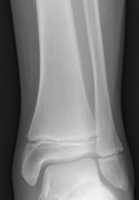
19 Dec Bone Growth Stops Earlier in Today’s Children
MedicalResearch.com Interview with:

Dr. Duren
Dana L. Duren, PhD
Professor, Director of Orthopaedic Research
Director of Skeletal Morphology Laboratory
Thompson Laboratory for Regenerative Orthopaedics
Department of Orthopaedic Surgery
Missouri Orthopaedic Institute, University of Missouri
Columbia, MO 6521
MedicalResearch.com: What is the background for this study? What are the main findings?
Response: The motivation for this study is the apparent accelerated maturity in children in the United States.

Radiogram of distal tibia (left) and fibula (right) showing two epiphyseal plates.
Wikipedia Image
We previously demonstrated that skeletal maturity (bone age) is more advanced in today’s children compared to children born in the first half of the 20thCentury (Duren et al., 2015).
n the current study (Boeyer et al., 2018) we show that a significant component of this advanced maturity status is the timing of epiphyseal fusion. In our study, nearly half of the epiphyses of the hand and wrist began or completed fusion significantly earlier in children born after 1995 than those born in the early part of the century, with differences as great as six to ten months for some bones, and mean differences on the order of 4 months in boys and 6 months in girls.
MedicalResearch.com: What should readers take away from your report?
Response: Physicians should be aware that
(1) Fusion timing has changed gradually over the past century and children in their practice today may begin and complete the process of epiphyseal fusion earlier than patients did even a few decades ago;
(2) Epiphyseal fusion, as a component of the skeletal maturity assessment, is now occurring earlier than standard methods describe; and
(3) Treatment timings should be based on the biology of the individual child regardless of traditional timing of skeletal maturity events.
MedicalResearch.com: What recommendations do you have for future research as a result of this work?
Response: The future of this research lies in elucidating the relationships between epiphyseal fusion events and other maturation traits related to puberty, including the adolescent growth spurt, which are also occurring earlier in today’s children. Through a grant from the National Institute of Arthritis and Musculoskeletal and Skin Diseases, my team is recalibrating and updating the methodology and reference sample used to evaluate skeletal maturity in clinical practice.
Citation:
Early Maturity as the New Normal
A Century-long Study of Bone Age
Boeyer, Melanie E., MS; Sherwood, Richard J., PhD; Deroche, Chelsea B., PhD; Duren, Dana L., PhD
Clinical Orthopaedics and Related Research®: November 2018 – Volume 476 – Issue 11 – p 2112–2122
doi: 10.1097/CORR.0000000000000446
[wysija_form id=”3″]
[last-modified]
The information on MedicalResearch.com is provided for educational purposes only, and is in no way intended to diagnose, cure, or treat any medical or other condition. Always seek the advice of your physician or other qualified health and ask your doctor any questions you may have regarding a medical condition. In addition to all other limitations and disclaimers in this agreement, service provider and its third party providers disclaim any liability or loss in connection with the content provided on this website.
Last Updated on December 19, 2018 by Marie Benz MD FAAD
